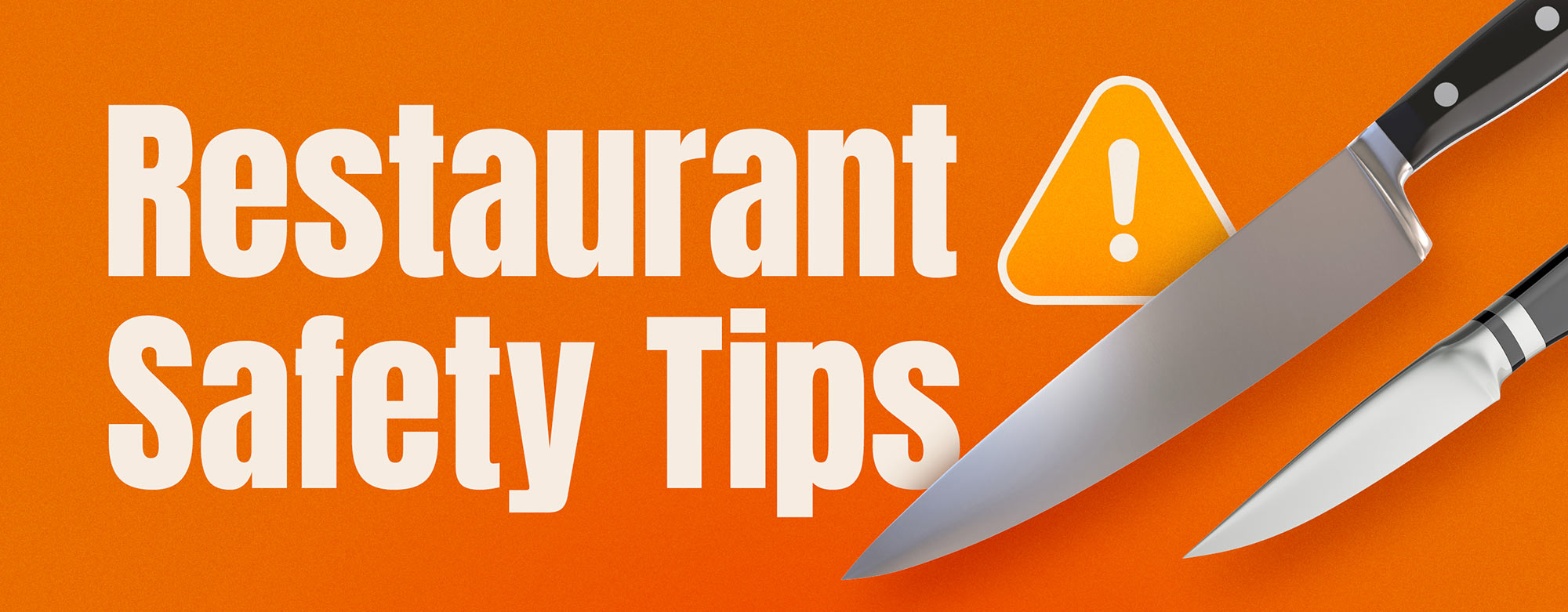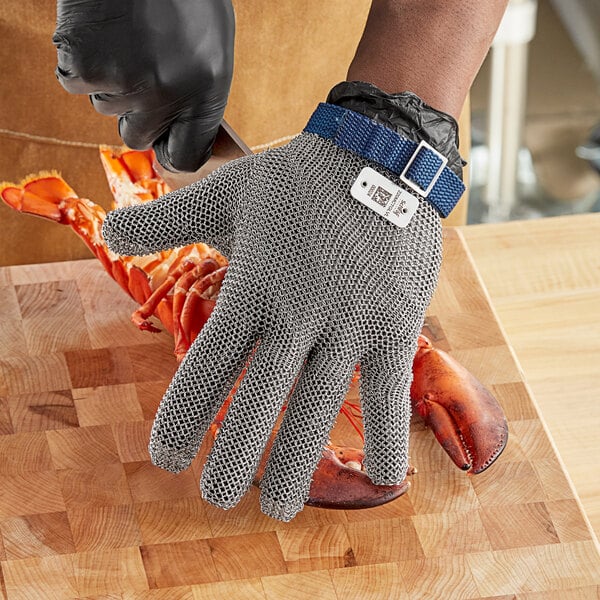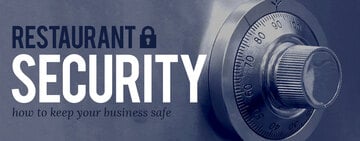
From handling sharp knives and hot equipment to navigating busy kitchens and dining areas, restaurant employees face a variety of hazards daily. Due to this, understanding and following safety guidelines is essential to creating a secure work environment and promoting a culture of safety among your restaurant staff. Not only do safety incidents threaten the wellbeing of your staff and customers, they also lead to lost productivity and increased costs for businesses. By implementing proper safety protocols and training, restaurants can prevent accidents and promote a culture of safety for all involved.
Shop All Safety and Security Products1. Train Your Employees in Restaurant Safety Procedures
To maintain a safe working environment, staff members must follow safety procedures, like the HACCP principles. Your kitchen is only as safe as your employee who has received the least amount of training. For this reason, investing time in training your employees is one of the most effective ways to make your restaurant safe.
Try to customize their training to processes used in your unique kitchen, and consider encouraging your employees to acquire ServSafe certification from the National Restaurant Association. This restaurant safety training program teaches your employees basic food safety and sanitation practices, including handling allergens and preventing cross-contamination.
2. Establish an Emergency Response Plan
Having a well-thought-out emergency response plan is crucial for ensuring the safety of your staff and customers in the event of an unexpected situation. Clearly outline the procedures that should be followed in case of an emergency. This includes protocols for evacuating the building, contacting emergency services, and addressing specific types of emergencies such as kitchen fires or severe weather. You should also keep your restaurant equipped with essential emergency supplies such as first aid kits, fire extinguishers, and emergency lighting.
3. Operate Restaurant Equipment Safely

A key part of training your employees is showing them how to use your kitchen equipment properly. Refer to the following checklist to ensure that misused or faulty equipment doesn’t cause an emergency in your kitchen.
- Use Equipment Properly - All pieces of equipment should be used according to the manufacturer’s instructions.
- Avoid Electrical Hazards - Keep electrical appliances away from wet areas, and check their cords for damage regularly. If there are cracks, frays, or other signs of damage, stop using the appliance immediately until you can replace its cord.
- Prevent Appliance Failure - Have your appliances regularly inspected by a professional. Do not attempt to repair broken appliances by yourself.
4. Practice Restaurant Fire Safety
According to data from the U.S. Fire Administration, roughly 5,600 restaurant fires are reported each year, with cooking as the leading cause of incidents. Making sure that kitchen staff members are alert and attentive to cooking dishes is the simplest way to prevent fires in your establishment.
However, there are other important measures to take when it comes to restaurant fire safety. Here are some steps you can take toward preventing fires in your kitchen.
Install Fire Safety Equipment
- Have multiple fire extinguishers in your establishment, and do not put them only in your kitchen.
- Install emergency lights and exit signs throughout your space.
- Look into appliances with fire suppression systems. When activated, these units can switch off your fuel supply and dispense substances that help to put out flames. Some units release these chemicals automatically and others have manual switches.
Implement Fire Safety Procedures

- Keep Flammable Objects Away from Flames - Do not store dish towels near your cooking equipment, and be sure that your employees are not wearing baggy clothing that could catch fire.
- Know How to Put out a Grease Fire - Do not use water to put out a grease fire. Instead, cover the flames with a metal lid and turn off the heat source. Use a fire extinguisher if the fire persists.
- Know How to Use a Fire Extinguisher - Ensure that each of your employees knows how to properly use a fire extinguisher. Additionally, always replace your extinguisher when it is low on fuel.
- Have a Fire Evacuation Plan - Keep this plan posted somewhere where everyone can see it.
- Turn off Power Sources - Teach your staff members how to turn off gas and/or electrical power in the case of an emergency.
5. Prevent Common Restaurant Injuries
With the proper restaurant safety rules in place, many of the most common on-the-job injuries can be avoided. Keep reading to find out which injuries happen most often and how to prevent them.
Lacerations and Punctures
With knives, slicers, and the occasional broken glass, restaurant employees are at risk for cuts constantly. To prevent knife injuries, your staff members should transport knives carefully around your kitchen space and pay attention to their cutting tasks, so they don't injure themselves or others. You can also provide your employees with cut-resistant gloves for extra hand safety. Broken glass should always be handled with a broom and protective gloves.
Burns
Your employees can easily get burned, even without a serious kitchen fire. Staff members should always wear oven mitts or use potholders to handle heated cookware.
Sprains and Strains
Your busy commercial kitchen can get crowded during meal services. Even if space is at a premium, it is important to keep commonly used items in easy-to-reach places. Repeated bending and twisting is not good for joints, so try to keep many of your tools at arm's length or close to it. Additionally, you should educate your employees on safe lifting techniques to avoid back injury when moving equipment or bulk ingredients.
Spills can also put your staff members and customers at risk for injury. Make sure that all spills are attended to as soon as possible and mark wet floors in all areas of your establishment.
Eye Injury
During cooking or cleaning, staff members' eyes are vulnerable to splashes of grease, sanitizing chemicals, and ingredients. Employees should exercise caution when cleaning their workspace or front-of-house areas and wear protective safety glasses when warewashing or cleaning up broken glass.
6. Provide Your Employees with Safety Equipment
While training and preparation are important for restaurant safety, some tasks are best performed with protective equipment. Consider providing these items to your staff to keep them safe in your kitchen.

- Protective Eyewear - Protecting your employees' eyes is essential in a bustling kitchen environment where sharp objects, hot liquids, and potential splashes are common. Providing protective eyewear can prevent eye injuries and ensure your staff can work with confidence.
- Back Support Belts - Employees in the foodservice industry often spend long hours on their feet, which can lead to back strain and discomfort. Back support belts can help alleviate some of the pressure on the lower back, promoting proper posture and reducing the risk of injuries.
- Cut-Resistant Gloves - Handling sharp knives and other kitchen tools poses a significant risk of cuts and lacerations. Cut-resistant gloves offer an extra layer of protection for your employees, reducing the likelihood of accidents and injuries.
- Aprons - Aprons are not only a staple uniform item but also an essential piece of safety equipment in the kitchen. They help protect clothing from spills, splashes, and stains, keeping your employees clean and safe while working.
- Hair Restraints - Keeping hair securely tied back or covered is crucial to maintaining food safety standards and preventing contamination. Hair restraints also prevent hair from getting caught on equipment, avoiding potential accidents.
7. Slip and Fall Prevention
Slip and fall accidents can be a major hazard in any restaurant setting, posing risks to both employees and customers. Implementing proper slip and fall prevention measures is crucial to maintaining a safe working environment and preventing injuries, spills, and many other types of accidents.

- Floor Maintenance - Implement a routine cleaning schedule and promptly clean up spills and other accidents. Additionally, you should place non-slip mats in areas prone to spills, such as near sinks and beverage stations.
- Footwear Policy - Establish a footwear policy that requires employees to wear slip-resistant shoes with proper traction to reduce the risk of slipping on wet or greasy surfaces in the kitchen or dining areas. You should also encourage employees to report any footwear issues promptly to ensure they are equipped with safe and appropriate footwear.
- Spill Cleanup - Train staff on proper spill cleanup procedures and provide them with the necessary tools, such as mops, buckets, and caution signs.
- Proper Lighting - All restaurant lighting, including lighting fixtures in workstations, dining areas, and storage areas, should be well-lit to improve visibility and reduce the risk of tripping or slipping. Light bulbs should be regularly checked and replaced to maintain adequate lighting levels throughout the restaurant.
- Signage and Safety Warnings - Place caution signs in areas where floors may be wet or slippery, such as near entrances, restrooms, and kitchen areas. Make sure that all safety signs are prominently displayed and easily visible to all staff members.
8. Restaurant Ergonomics
Ergonomics is the science of designing a workspace to fit the needs and capabilities of the worker, with the goal of minimizing discomfort and fatigue. In any commercial kitchen or restaurant setting, maintaining proper ergonomic safety measures is crucial in preventing injuries and keeping employees comfortable while they complete their daily tasks.
To ensure your commercial kitchen is designed with ergonomics in mind, try adjusting the height of work surfaces, chairs, and equipment to promote good posture and reduce strain on the body. Staff should also be encouraged to use equipment like dollies or carts for transporting heavy items, and anti-fatigue mats should be placed in areas where staff are standing for long periods of time. Finally, regular breaks should be implemented and tasks should be rotated between staff members to prevent overuse injuries.
Maintaining a safe working environment in your restaurant is crucial for the well-being of your employees and the success of your business. By implementing the restaurant safety tips outlined, you can create a culture of safety that protects both your staff and customers. Regular training, proper equipment maintenance, and clear communication are key components of a successful safety program. Remember, safety is everyone's responsibility in the restaurant industry, and by prioritizing it, you can prevent accidents and create a positive and safe work environment.





